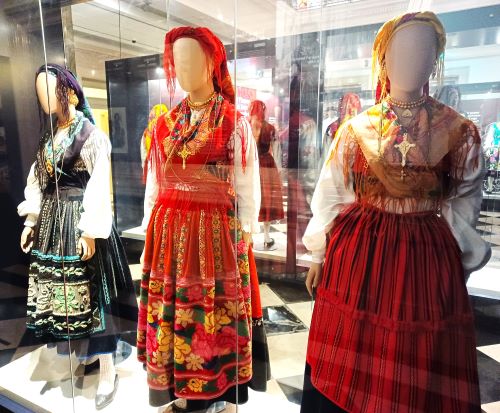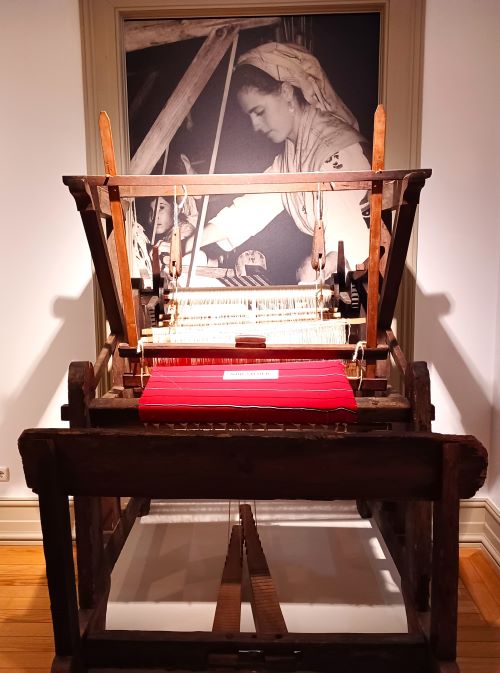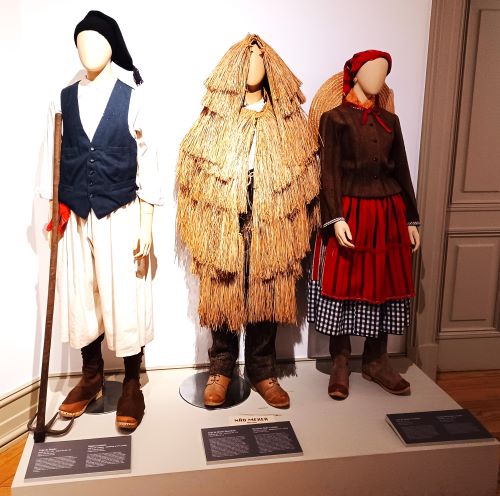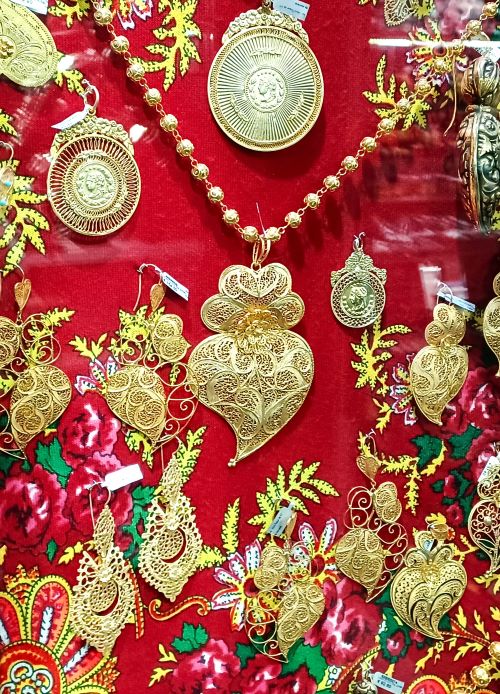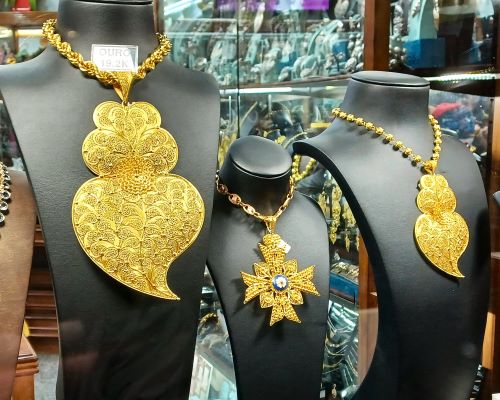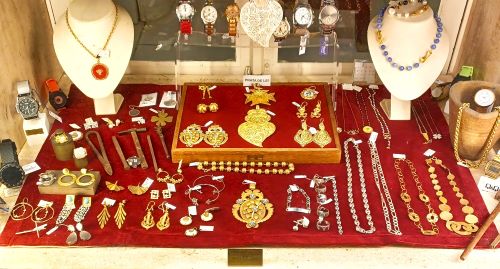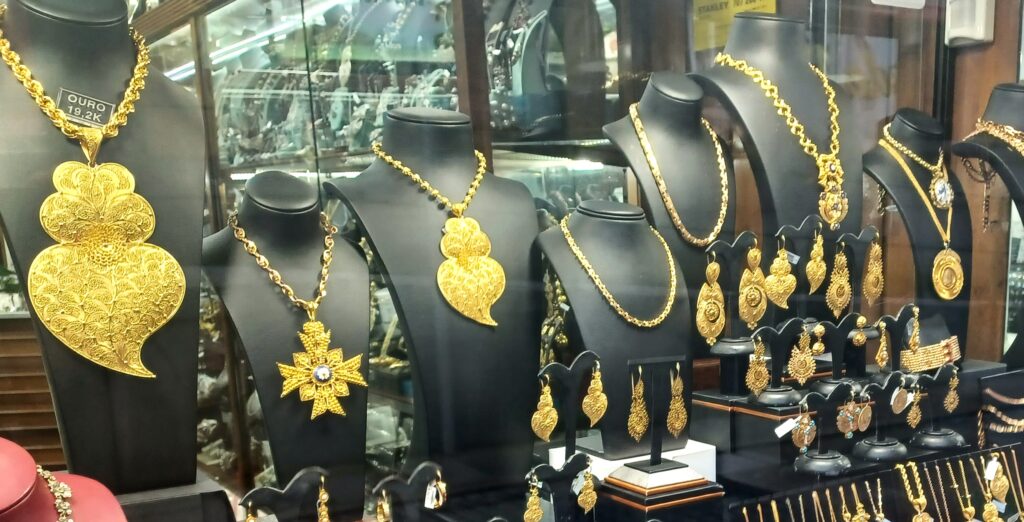An hour north of Porto lies a small city with a fascinating culture of gold jewelry, embroidered love letters, and delicious local pastries.
A Short History
Early Homo heidelbergensis were in present-day Portugal 400,000 years ago and humans arrived in what is now Portugal around 40,000 years ago. The first humans settled in the area near present-day Viana do Castelo about 15,000 years ago during the Middle Stone Age.
Later, the Roman Empire, followed by the Germanic Suebi Kingdom ruled the region. Unlike the regions of Portugal to the south, this region was never conquered by the Moors who ruled Portugal for 500 years.
The city was formally chartered in the 13th century. Viana grew wealthy in the 16th century due to its port where many ships departed and arrived from Africa, Asia, and the New World.
Lencos dos Namorados
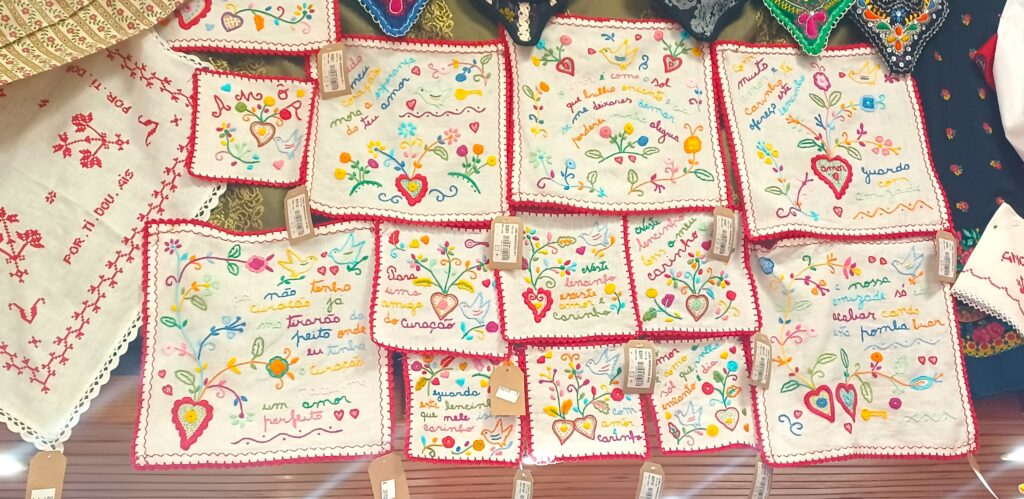
In the 19th century, local women began the custom of embroidering kerchiefs called Lencos dos Namorados. Translated to Valentine’s Scarves, they were worn by women of marrying age. The scarves’ embroidery was often in the form or a love letter with verses and hearts showing the woman’s affection and commitment. She would give the scarf to a potential suitor who would wear it publicly to show that he returned the woman’s love. However, if the man did not share these feelings, he would return the Valentine Scarf to the woman, leaving her heartbroken.
Today, original Lencos dos Namorados from 200 years ago are valuable cultural artifacts. Shops in Viana are filled with newly made hand (and machine) embroidered Valentine’s Scarves. Some quality made examples retail for hundreds of Euros.
Because the rural woman of this area were often illiterate in the 19th century, many of these scarves had grammatical errors. When the scarves are reproduced today, the grammatical errors are kept to preserve their historical accuracy.
Foodie Viana do Castelo
Vegetarian Viana
Only 35,000 people live in Viana do Castelo so it probably shouldn’t come as a surprise that vegetarian and vegan food can be a bit hard to come by. Many things you might expect to be vegetarian, like soup or salads are often topped with Chorizo (sausage) or Bacon.
However, there is one vegetarian restaurant called Terra that’s about a 15 minute walk outside of town. Good brunch items, sandwiches, snacks, and drinks in a chill atmosphere.
Other than that, the menus of Viana are populated with seafood (it’s on the ocean, after all) and meat dishes. In fact, a lot of menus will feature only two sections for main courses, Peixe (fish) and Carne (meat). However, most traditional restaurants will have a nice salad on the menu. Unlike some other parts of Portugal, the salads are interesting with lots of veggies, not just some lettuce, onion, tomato and a stray slice of cucumber. In addition, if you don’t see anything on the menu, ask your server, most chefs are happy to prepare something for you.
Probably my favorite traditional restaurant in Viana is Casa de Pasto Maria de Perre. The staff is friendly and they have a fresh salad on the menu. There’s also “Sautéed Vegetable” on offer, which changes according to what’s in season. The wine list is good and I’m always glad to see half bottles available, especially when you’re having lunch and don’t want to end up napping back in your hotel the rest of the day.
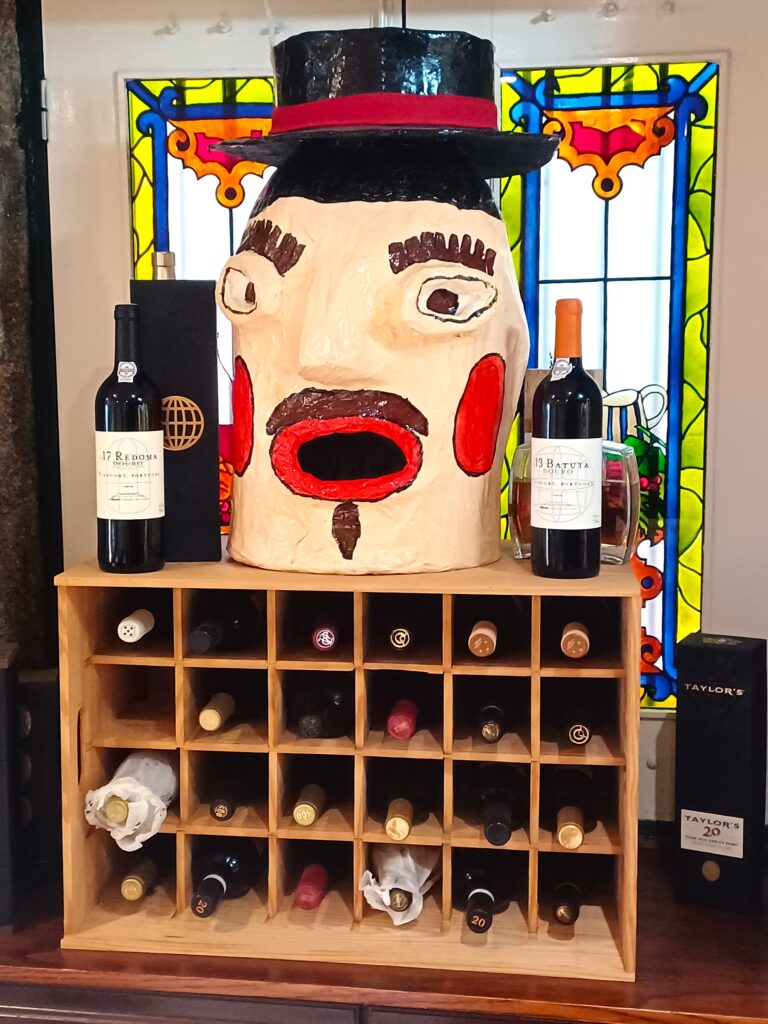
There’s also several burger joints in town and most have a veggie burger on the menu. But, for my money, I like À Moda Antiga – Retro Market & Bistro, a hip place decorated with retro radios, cameras, and bikes. They also have a small market with local condiments and snacks. There’s a good wine list to go with their veggie burger.
Foz Viana has an ideal spot on the river. Their veg. options are limited but they have a decent wine list and the view can’t be beat.
Almost every city in Portugal has an Indian restaurant and many of them are very good. Portugal had a colony in Goa, India, so many immigrants have come to Portugal to live and work. In Viana, I like Indian Punjabi Restaurante. They have a dedicated vegetarian/vegan menu with lots of great dishes. Plus, the serving vessels are adorable!
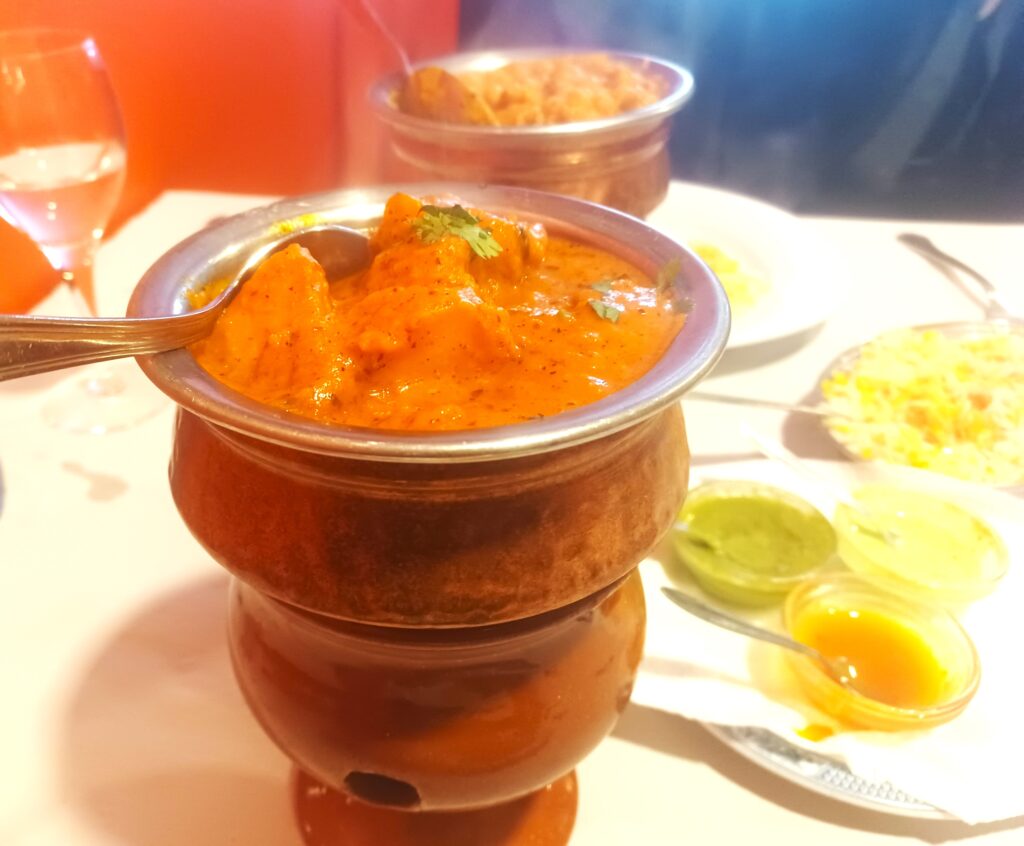
Caldo Verde
Viana do Castelo is in the Minho province, the area where Portugal’s most famous soup, Caldo Verde was invented.
Caldo Verde is a simple soup made with potatoes, greens, onions, and olive oil and seasoned with salt, pepper, and garlic. The greens are normally a sort of Portuguese Collard called Couve-galega, though Mustard Greens and Turnip Greens are also used. The greens are julienned into ribbons, which is especially useful since they can sometimes be a little fibrous.
The soup is often topped with Chorizo (Portuguese Sausage) and served with bread (Pao) for dunking.
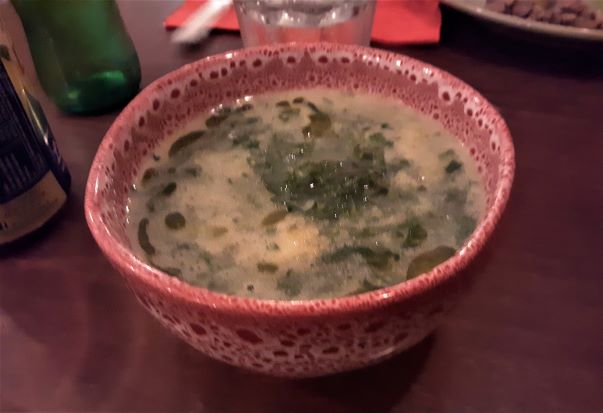
Besides the types of greens used, there are regional variations in Caldo Verde. Corn Bread or Rye Bread may be used rather than the typical Portuguese crusty bread. Besides Portugal, Caldo Verde is often on the menu in places with large Portuguese populations like Toronto, Fall River & New Bedford, Massachusetts, Rhode Island, and, of course, Brazil.
If you’re looking for Caldo Verde in Viana, Casa de Pasto Maria de Perre does a good job as does O Laranjeira Pensão Restaurante. But, unlike some other towns in the region, Caldo Verde isn’t as popular here as some other places. That’s probably because seafood soup is so popular in Viana, so not every restaurant will have Caldo Verdo on the menu.
Vegetarians should be aware that even if you get Caldo Verde without Chorizo, sometimes the broth is made with a ham hock. Also, the potatoes are often boiled with the Chorizo. Make sure you ask before ordering.
Pastries
Viana is filled with outstanding bakeries churning out pastries with local origins as well as those that have been adapted from further afield.
Torta de Viana
Nearly every city and town in Portugal has it’s own unique pastry. In Viana do Castelo, that pastry is the Torta de Viana. The pastry can trace its roots to the Monastery of Vila do Conde, a monastery about 25 miles south of Viana and famous for their skills with sweets. Some nuns came to Viana’s Convent of Santa Ana. There, 500 years ago, they created the first Torta de Viana.

The cake is a thin sponge cake slathered with egg custard and rolled up. It is then sliced and served, often with a topping of powdered sugar and/or cinnamon. One delicious variation is to take the slice and dunk it in chocolate. You can get this version at Manuel Natário, one of my favorite old-school bakeries in Viana.
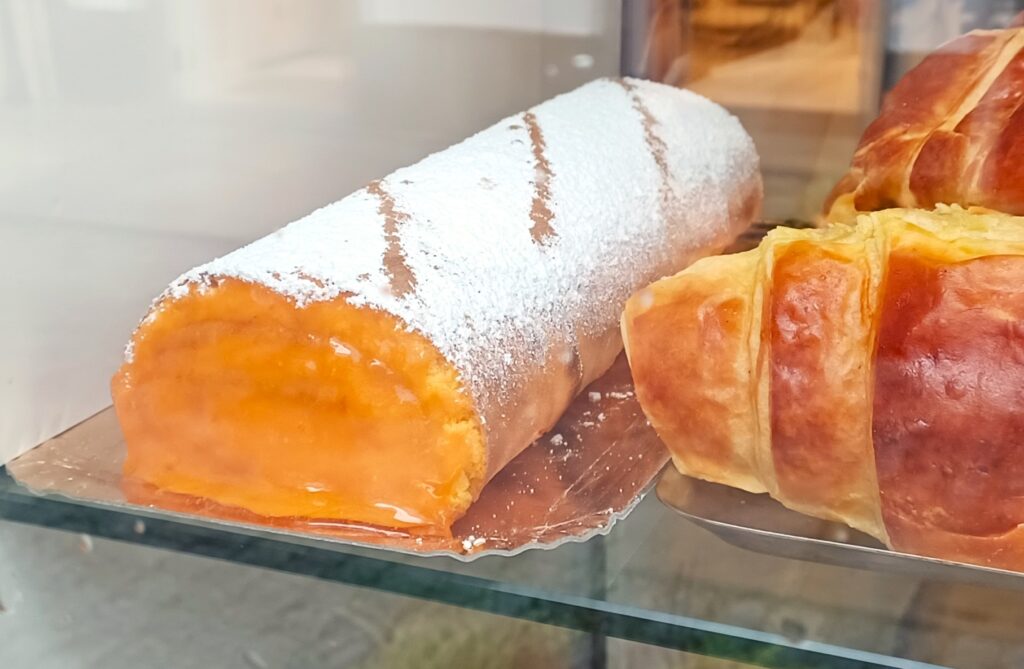
If you follow my blog or are familiar with Portuguese sweets, the Torta de Viana may sound familiar in its ingredients and preparation. The delicious Torta de Azeitão from the Setubal region is similar. I’ve written about this yummy cake and did a taste test video, as well.
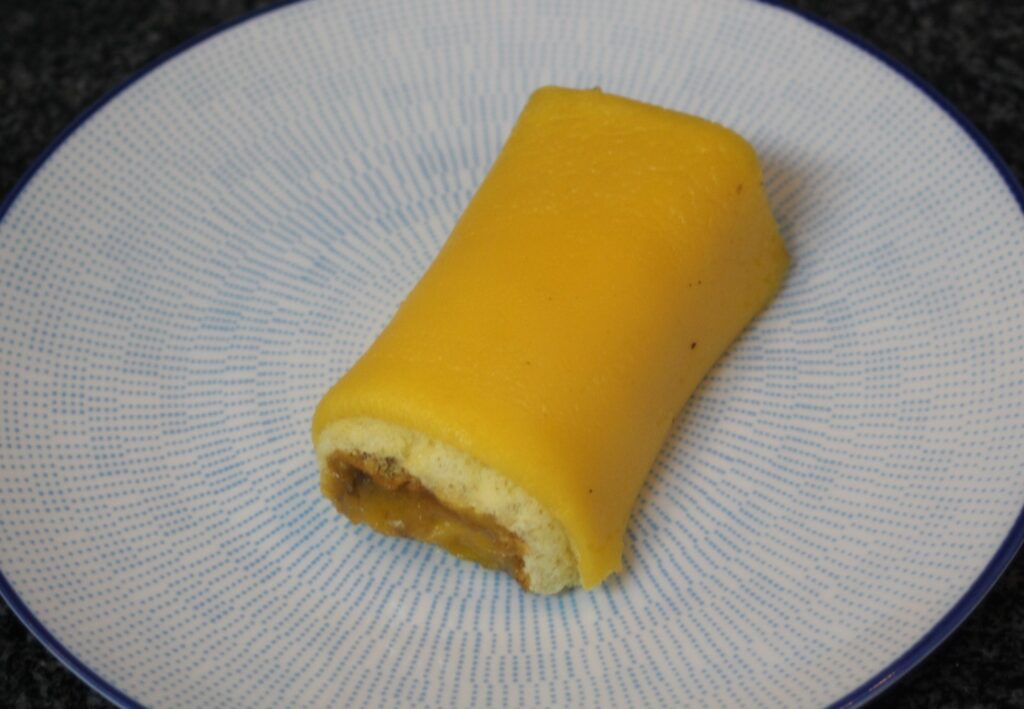
If you want to visit the Convent of Santa Ana to pay tribute to the nuns who invented this delicious cake, it now goes by the name Convento da Caridade and functions as a nursing home. However, the church is open.
Bola de Berlim
There’s an oft-repeated story that President John F. Kennedy, when giving a speech in Berlin in 1963, said “Ich bin ein Berliner,” which translates to “I am a Berliner,” showing his solidarity with the people Germany in general and Berlin specifically during the time shortly after the construction of the Berlin wall which separated the city into East and West Berlin. Decades after the speech, there was a rumor that what Kennedy was actually saying “I am a donut,” in German venacular, referring to the pastry called a “Berliner.”
A Berliner is a jelly filled donut, which had been known in Germany as far back as 500 years. According to legend, the name Berliner was coined when a baker for the Prussian Army began frying donuts for the troops. They called the treat a Berliner after the baker’s home city.
However, in the Berlin of the 1960’s, a jelly donut was known as a Pfannkuchen (literally “Pan Cake”), In all likelihood, the 120,000 people in attendance for JFK’s speech recognized that he was saying he is a Berliner and not a jelly donut.
In Portugal, the Berliner is known as “Bola de Berlim” (Berlin Ball). However, rather than being filled with jelly, a Bola de Berlim is filled with an egg custard and cut halfway through to expose the filling. They are then coated with granulated or confectioners sugar.

While Bolas de Berlim are available in most bakeries in Portugal, they are especially good in Viana do Castelo. Manuel Natário has set times when they are available (11:30 and 4:30) and people line up to get them. Zé Natário also has excellent Bola de Berlim.
Ich bin ein Bola de Berlimer!
Jésuita
The Jésuita pastry originated in the town of Santo Tirso, about an hour’s drive from Viana. Some say it was a Spanish baker working in Santo Tirso that invented the pastry, others say it was invented in one of town’s convents.

Made with puff pastry and filled with egg custard and topped with meringue. The pastry is cut into a triangular shape to resemble a Jesuit’s habit. Variations on the Jésuita include filling the pastry with chocolate and other delights. The meringue on top can also have different flavors or be omitted altogether in favor of sliced almonds (my favorite).
I’ve had very good Jésuitas all over northern Portugal. In Viana do Castelo, Leitaria Do Carmo is a terrific old-school bakery with a variety of different Jésuitas.

Drinking in Viana
Vinho Verde
The Minho Region (where Viana is located) is famous for Vinho Verde. Translated to “Green Wine” the name doesn’t refer to the color of the grapes, but instead that the wine is young.

The vast majority of Vinho Verde is white, though there are some red and rose bottles. The most popular grapes for white Vinho Verde are Alvarinho and Loureiro.
Traditionally, Vinho Verde’s characteristic effervescence came from malolactic fermentation. Today, carbonation is usually added after the fact, a more economical method.
I complained about the lack of wine bars in northern Portugal (outside of Porto, which has many), While most restaurants only have one selection of red and white by the glass, there is a workaround. Half bottles are available on many menus. A half bottle is about 2.5 glasses, making it nice to sample with 2 people. Or, with a larger party, you can get a few half bottles and sample a few different wines. One of my favorite wine lists is at the excellent traditional restaurant Casa de Pasto Maria de Perre. Right on the river, Foz Viana is another one of my favorite places with a good wine life.
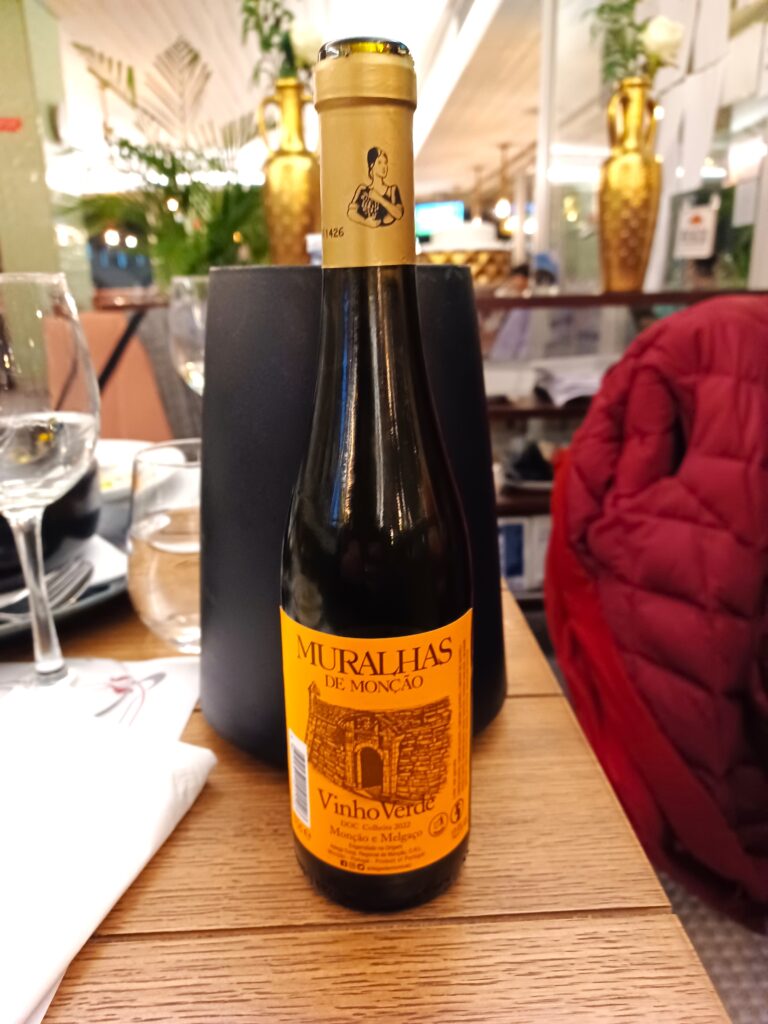
Things to do in Viana
Sanctuary of the Sacred Heart of Jesus / Mount of Santa Luzia (Santuário do Sagrado Coração de Jesus / Monte de Santa Luzia)
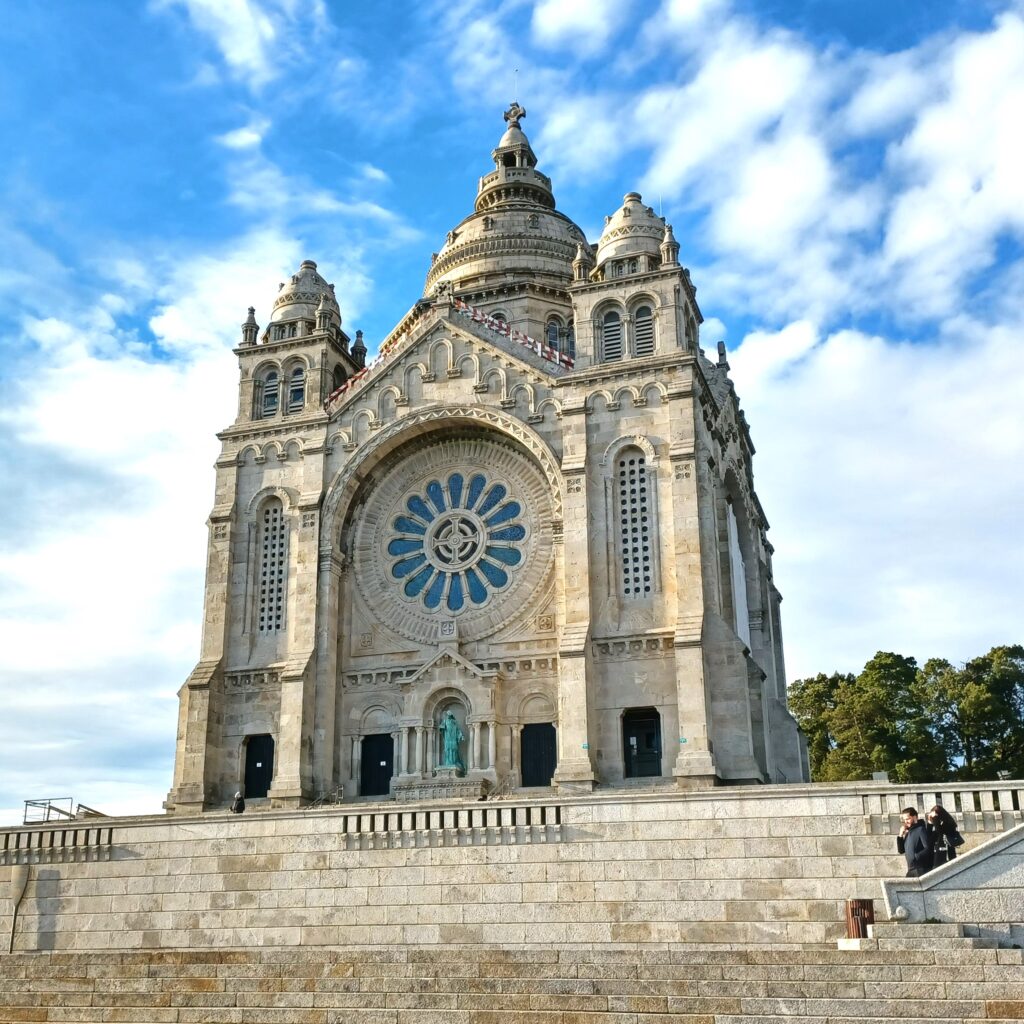
Without a doubt, the Sanctuary of the Sacred Heart of Jesus / Mount of Santa Luzia (Santuário do Sagrado Coração de Jesus / Monte de Santa Luzia) is the top attraction in Viana do Castelo.
Towering above the city, the church commands incredible views of the Lima River, the city of Viana do Castelo, the port, and over the Atlantic Ocean.
Since Medieval times, there has been a hermitage on Monte de Santa Luzia, patron saint of eyesight.
The story goes that at the end of the 19th century, Cavalry Captain Luís de Andrade e Sousa found that his eyesight was failing. He visited the small chapel on Monte de Santa Luzia and prayed to Saint Lucy. His eyesight restored (how come we never hear about the people whose prayers weren’t answered in these stories?) he helped spearhead the construction of the Sanctuary of the Sacred Heart of Jesus beginning in 1904, with the project completed in 1959.Hard to believe this Gothic/Byzantine looking chruch was only finished 75 years ago.
The views from the church grounds are definitely spectacular, called some of the best in the world. But, the interior of the church isn’t all that interesting. It is free to enter and it’s worth a look for the stained glass, especially the front rose window which was made in Lisbon and shipped north to Viana.

The best views are gained from the top of the church tower. To get to the tower you need to go outside the church and find the entrance on the side (entrance fee). Two hundred ever-increasing steps of claustrophobia lead to the tower with a windy outlook that lets you see Viana and miles and miles beyond. Not to be missed.
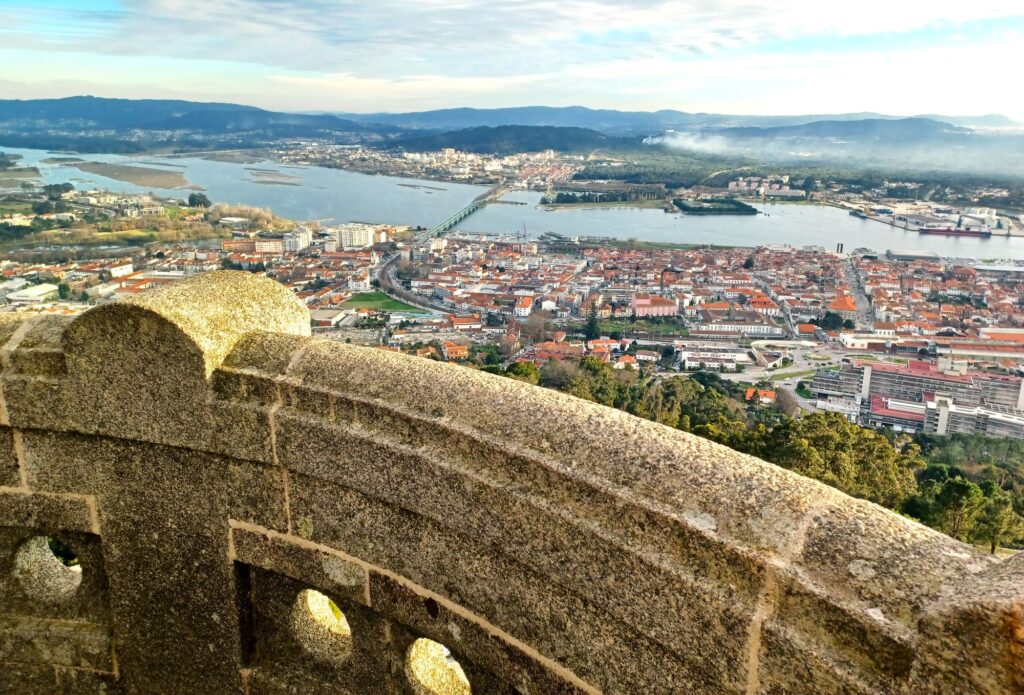
Citânia Santa Luzia
A short 15 minute walk from the Sanctuary of the Sacred Heart of Jesus / Mount of Santa Luzia is the archaeological site known as Citânia Santa Luzia.
Built around 500 BCE, the Iron Age settlement was thriving hundreds of years before the arrival of the Romans. The fortified city lasted well into the Roman and Visigoth occupations.
Exploring the site on raised walkways, you’ll see foundations of homes and the city’s wall as well as other structures. Excavation of the site began in the 19th century and only a third of the city has been uncovered. Much of the rest of the city lies under the modern roads and houses in the area. The construction of the Sanctuary of the Sacred Heart of Jesus / Mount of Santa Luzia also destroyed much of Citânia Santa Luzia.
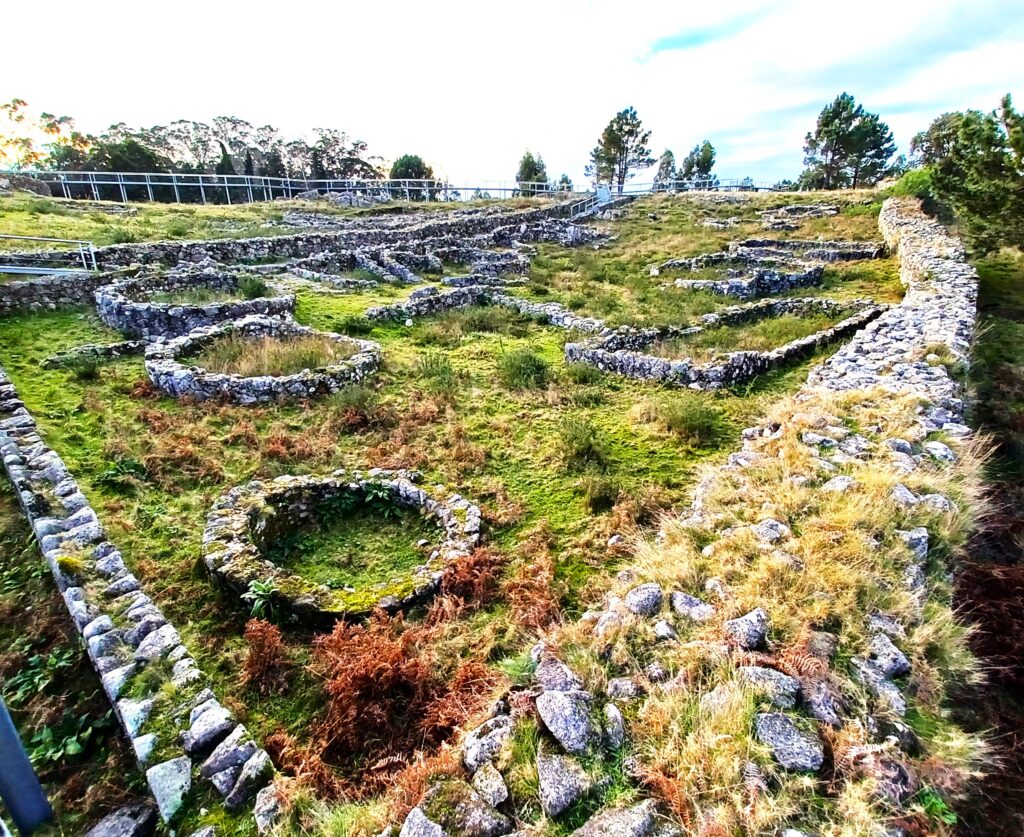
Unfortunately, there’s no signage to explain what you’re looking at. However, it’s still interesting to walk around and imagine what life was like here 2,500 years ago.
Museu do Traje (Costume Museum)
Viana do Castelo and the surrounding villages are famous for their traditional folk costumes worn during the 18th and 19th centuries. The outfits are different depending of the village the woman was from or the occasion for which they were being worn.
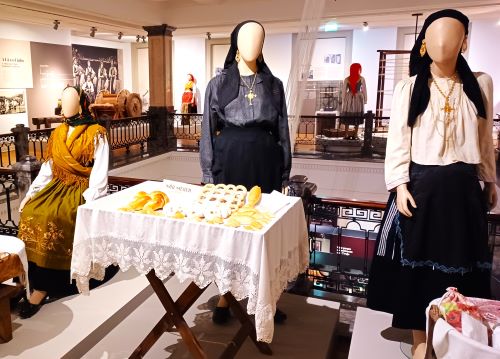
My favorite museum in Viana, the Museu do Traje, does a great job of explaining the history these rural costumes with displays of outfits that were worn for festivals, for going to the market, for working, and even for weddings. Surprisingly, the bride wore a black wedding dress rather than the white we are used to.
The museum is laid out on several floors and even has space dedicated to the making of the cloth. It seems every rural household had its own loom where women would weave fabric.
While I’m no fashionista, the intricate woven designs of the skirts and blouses are fascinating. I can’t imagine the time and skill required by the women to make these pieces.
In the basement is the “Sala do Ouro” or “Gold Room” where exquisite pieces of gold jewelry are displayed behind glass in a vault. As the region around Viana do Castelo became more prosperous, people wanted to show off their wealth.
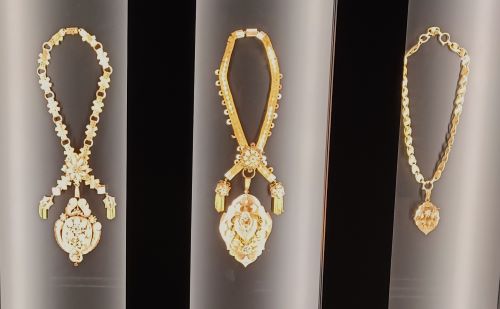
Coração de Viana
The Coração de Viana (Heart of Viana) is the most popular form of jewelry in the area, and now throughout Portugal. Made of filigree gold (and sometimes silver), the threads are woven into incredibly intricate patterns to create the famous heart shape. There are lots and lots of jewelry shops around the city with Coração de Viana for sale. The best is probably Ourivesaria Freitas – Manuel Rodrigues de Freitas since many of their pieces are on display at the museum.
Coração de Viana has become so popular, in fact, that it has become the symbol of the city. You’ll see it not only in jewelry stores, but on pictures, signs, and t-shirts. I even saw a cake in the shape of a Coração de Viana in the window of a bakery!
In addition to the Gold Room, there are lots of pictures in the Museu do Traje of women wearing the Coração de Viana. You’ll not only be awestruck by the gorgeous pieces themselves, but also by the vast quantity of jewelry that some women wear around their necks. They put the richest 90’s rappers to shame!
Romaria de Nossa Senhora da Agonia (Pilgrimage of Our Lady of Agony)
Every August, the Romaria de Nossa Senhora da Agonia festival fills the streets of Viana with music, parades, and dancing. Started in the late 18th century by fisherman praying for safe waters, today the festival is the place to be if you want to see the real people wearing the Costumes of Viana do Castelo. Many women will also be seen draped in pieces of Coração de Viana.
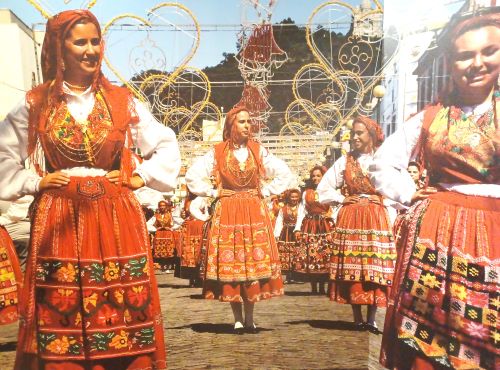
Percussion groups and social clubs march in the streets, often wearing traditional costumes. Musical and dance groups perform on stages. And, of course, vendors sell everything from trinkets to food.
It’s the biggest celebration in Viana do Castelo, so if you decide to go, be sure to book your hotel early.
Museu de Artes Decorativas
Housed in an 18th century mansion, the Museu de Artes Decorativas has an impressive collection of Portuguese ceramics, paintings, and Indian-Portuguese furniture (Portugual and India were active traders in the 16th, 17th & 18h centuries).

But, the highlight of the museum is the collection of Azulejo (tile) murals. While many Azulejo works in Portugal depict religious scenes from the Bible or typical Portuguese life, the murals in the Museu de Artes Decorativas show the life of Portuguese royalty, much of it a grotesque exaggeration. A team of lions pulling a royal carriage, anyone?

Beaches
Viana do Castelo is at the entrance to the Atlantic Ocean and there’s nice beaches here for recreation or just lying on the sand. Be forewarned, this is the Atlantic, not the Mediterranean. The water is much colder!
Praia do Cabedelo is just across the river in Darque. Water sports, including surfing are very popular here. You can party late into the night at the bars that line the beach if that’s your thing. Behind the beach are some low dunes and a pine forest. There’s a seasonal ferry that runs between Viana and Darque. The ticket office is at the marina.
Closer to town is Praia Norte, a rocky beach near the 17th century Fort Areosa. There’s a nice promenade to walk or bike along the waterfront.
Daytrips from Viana
Viana do Castelo is often a daytrip itself from Porto or Braga. Both cities are within easy reach via train, bus, or car.
Porto
Porto is one of the gems of Portugal, worth a couple days at least, though you could easily fill a week. I’ve written a complete Foodie Travel Guide to Porto.
Braga
Braga is known for its incredible churches including Bom Jesus do Monte, which has some of the best views in Portugal. I’ve written a complete Foodie Travel Guide to Braga.
Transportation
The closest major airport to Viana do Castelo is the Porto Airport (Francisco Sá Carneiro Airport). Flixbus and Rede Express have a few buses that run direct from Porto Airport to Viana do Castelo. The trip takes about an hour
There is regular train service from downtown Porto (75 minutes, make sure you buy a ticket on the route) and Braga (1.5 hours, transfer in Nine). Buses are quicker but less frequent from Braga. Many scheduled buses depart from Porto to Viana.
There is local bus service mostly used by workers in the city. The service is operated by AVIC – Transportes Urbanos de Viana do Castelo.
Taxis are widely available. Uber and Bolt are also available for rideshare but there are only a few drivers in the city. You may end up waiting for a car.
A seasonal ferry that takes passengers across the river to Darque and the Praia do Cabedelo. Round trip service operates between 9 and 6. The ferry and ticket office are at the Viana do Castelo marina.
The most interesting piece of transport in the city is the Elevador de Santa Luzia, a funicular that takes you to the Sanctuary of the Sacred Heart of Jesus.
Index of Things to Do in Viana
Elevador de Santa Luzia
Funicular takes you to the Sanctuary of the Sacred Heart of Jesus / Mount of Santa Luzia.
Av. 25 de Abril, 4900-496 Viana do Castelo, Portugal
Sanctuary of the Sacred Heart of Jesus / Mount of Santa Luzia (Santuário do Sagrado Coração de Jesus / Monte de Santa Luzia)
Top attraction in Viana. Iconic church with incredible views.
Monte de Santa Luzia,mount in Santa Lucia POD 21, 4901-909 Viana do Castelo
Citânia Santa Luzia
Archeological site from the Iron Age.
Monte de Santa Luzia, 4901-910 Viana do Castelo
Sé Catedral de Viana do Castelo (Viana do Castelo Cathedral)
Cathedral with impressive alter.
Largo do Instituto Histórico do Minho 19, 4900-522 Viana do Castelo
Santuário de Nossa Senhora da Agonia (Sanctuary of Our Lady of the Agony)
18th century church with an alter by André Soares and a painted ceiling.
R. de Monserrate 12, 4900-350 Viana do Castelo
Praca da Republica
Square with a beautiful fountain and lined with cafes (some open seasonally)
Museu do Traje (Costume Museum)
Fascinating museum with displays of traditional clothing from the region as well as the famous gold jewelry.
Praça da República 58, 4900-539 Viana do Castelo
Museu de Artes Decorativas (Museum of Decorative Arts)
Museum featuring azulejo tile murals as well as ceramics, paintings, and furniture.
Largo de São Domingos 4900, 4900-000 Viana do Castelo
Santa Casa da Misericordia
Amazing azulejo tile murals.
Passeio das Mordomas da Romaria, 4900-532 Viana do Castelo
Praia do Cabedelo
Lovely beach in Darque just across the river from Viana.
Praia Norte
Rocky beach with a sandy spit and breakwater.
Monumento ao 25 de Abril (Monument to April 25th)
Monument dedicated to the victims of the Portuguese dictatorship which was overthrown on April 25th, 1974.
Castelo Santiago da Barra (Castle Santiago Barra)
16th century fort built to defend the city at the mouth of the Lima River and Atlantic Ocean.
Index of Places to Eat & Drink in Viana
Casa de Pasto Maria de Perre
Terrific traditional Portuguese restaurant with a couple veg. options.
R. de Viana 118, 4900-326 Viana do Castelo
Terra Cafe and Bistro
Chill vegetarian restaurant about a 15 minute from the city center.
R. de Monserrate 384 2º andar, 4900-355 Viana do Castelo
À Moda Antiga – Retro Market & Bistro
Cool restaurant with market of hip, retro items like cameras, radios, and bikes.
Largo João Tomás da Costa 63, 4900-509 Viana do Castelo
Indian Punjabi Restaurante
Indian restaurant with lots of veg options.
R. Frei Bartolomeu dos Martires 179, 4900-307 Viana do Castelo
Foz Viana
Large space right on the river. Lovely views. A couple veg. options.
Praça da Liberdade, 4900-040 Viana do Castelo
Mercado na Loja
Cafe/Restaurant with a couple veg. options. Good breakfast, too.
R. António Machado Vilas Boas 294, 4900-503 Viana do Castelo
O Laranjeira Pensão Restaurante
Traditional Portuguese restaurant with good desserts. Also has Caldo Verde on the menu.
R. Manuel Espregueira 24, 4900-318 Viana do Castelo
Restaurante Taberna do Valentim
Portuguese restaurant with limited veg. options. Nice desserts.
Av. Campo do Castelo 45, 4900-359 Viana do Castelo, Portugal
Manuel Natário
Fantastic old school bakery with famous Bola de Berlim. Also, chocolate covered Torta de Viana.
R. Manuel Espregueira 37, 4900-318 Viana do Castelo, Portugal
Leitaria Do Carmo
Famous for their Jésuita.
R. da Bandeira 327, 4900-561 Viana do Castelo, Portugal
Zé Natário
Known for their Bola de Berlim and Meias Lunas (half moon pie).
Av. dos Combatentes da Grande Guerra 23, 4900-515 Viana do Castelo, Portugal
Pastelaria Dantas
Bakery with Torta de Viana and a massive marshmallow filled pastry called Russo.
R. Manuel Espregueira 269, 4900-344 Viana do Castelo, Portugal
Confeitaria A Brasileira
Bakery has been in business since 1902.
R. Sacadura Cabral 23, 4900-517 Viana do Castelo, Portugal
Concha
Terrific old-school bar.
Av. dos Combatentes da Grande Guerra 198, 4900-344 Viana do Castelo, Portugal
Index of Shopping in Viana
Ourivesaria Freitas – Manuel Rodrigues de Freitas
Terrific traditional jewelry. Much of the jewelry on display at the costume museum is from here.
R. Sacadura Cabral 16, 4900-528 Viana do Castelo
Mercado Municipal Viana do Castelo
Tiny local market.
Av. Cap. Gaspar de Castro 119, Viana do Castelo
Feira Semanal da Meadela
Mishmash of vendors selling clothing, housewares, and snacks.
Pç da Linha do Vale do Lima, 4900-296 Viana do Castelo
Places to Stay in Viana
Avenida Viana Boutique Suites
Lovely rooms right on the main drag.
Av. dos Combatentes da Grande Guerra 160, 4900-544 Viana do Castelo, Portugal
Atrium Aveiras
Cool apartments in Viana.
Av. Campo do Castelo 48, 4900-359 Viana do Castelo, Portugal
About the Author

Brent Petersen is the Editor-in-Chief of Destination Eat Drink. He currently resides in Setubal, Portugal. Brent has written the novel “Truffle Hunt” (Eckhartz Press) and the short story collection “That Bird.” He’s also written dozens of foodie travel guides to cities around the world on Destination Eat Drink, including in-depth eating and drinking guides in Portugal to Lisbon, Porto, Sintra, Évora, Braga, Loulé, Almada, Monsaraz, and Batalha. Brent’s podcast, also called Destination Eat Drink, is available on all major podcasting platforms.

